
I sat up curiously from my seat around our indoor dining table. In the distance was the unmistakable chorus of bells and each second their chiming got louder. What on earth? The frenzied jingling was accompanied by a thrumming of hundreds of hooves.
I made my way to the window and threw open the shutters. Wincing as brilliant sunlight streamed through the now-open frame, I made out a mass of stampeding sheep just across the road. The herd stumbled ungraciously down a steep slope before charging out of the dry field and down the empty road which lay to the side of our cottage.
Marching beside their flock was a farmer, a huge rifle in his hands.
I watched inquisitively as the sheep were ushered down the road, taking up the bulk of the concrete with their bells humming like a drone. Although loud, I found the scene before me rather peaceful and couldn’t draw my gaze from the mass of bodies streaming right outside my window. They were so close that I felt that if I reached out an arm, I could touch them! Well, if my arms were twice their actual length… But you get the point!


I finally tore my stare away from the stampede. As much as I could enjoy watching sheep all day, there were some more gems out there for me to explore. A day watching sheep wouldn’t exactly be my best use of my last day in Kefalonia.
Instead, Lewis and I had a busy itinerary ahead. After delving into the ghost town of Old Farsa yesterday, we were interested in continuing with the theme of ancient Kefalonia and journey to a village which was apparently withstood the devastating 1953 earthquake. Drakopoulata village is meant to be home to intact examples of ancient Kefalonia architecture which has stood the test of time and defied nature’s fury.
We were going to couple our visit to Drakopoulata with an outing to the coastal town of Sami which sits on the very east coast of Kefalonia, a coastline which we were yet to see. Sami was also home to the notorious Melissani cave which I was excited to become acquainted with.

Drakopoulata village is built on the slopes of Agia Dynati mountain, in central Kefalonia. Surrounded by lush forests, the village sits at 230 metres above sea level. As of 2018, there are 32 permeant residents in the village. Towering above Drakopoulata, sitting on the summit of Agia Dynati, the second highest mountain in Kefalonia, are wind turbines – the very turbines that I have had the pleasure of viewing from my cottage window for the last few days!
I glanced at my satnav as we snaked round the side of the mountain, thick forests either side of us. Hugging the road were a couple of houses, modern and clearly re-built since the earthquake. Intertwined with them were the empty carcasses of buildings which remain left alone and in a state of disrepair. The higher up the mountain we got, the more sparse the buildings became.
“We’re nearly there.” I remarked. “Take the right here.”
We turned right up a steep, narrow incline where there were a couple of modern houses. Our tyres bumped ungracefully on the poorly-maintained road. Up ahead, it looked like the road came to an abrupt stop at the base of a hill dotted with derelict ruins.
“We’re here.” I commented.
Lewis’ puzzled look echoed my thoughts. We pulled up beside the crumbling remnants of a house and glanced across the road at the skeletal remains of another. Without a roof, the building across the road had its contents on full display. I could make out olive-presses amongst the thick foliage which was now taking over. We had expected to find more intact houses, perhaps a few that had inhabitants. However, despite the occasional renovated house, we were parked within what can only be described as a graveyard of houses. It seemed odd that residents had renovated the odd house here and that their neighbouring houses were just ruins. To be honest, it sounded like my kind of place. I’ve never been a fan of having neighbours.
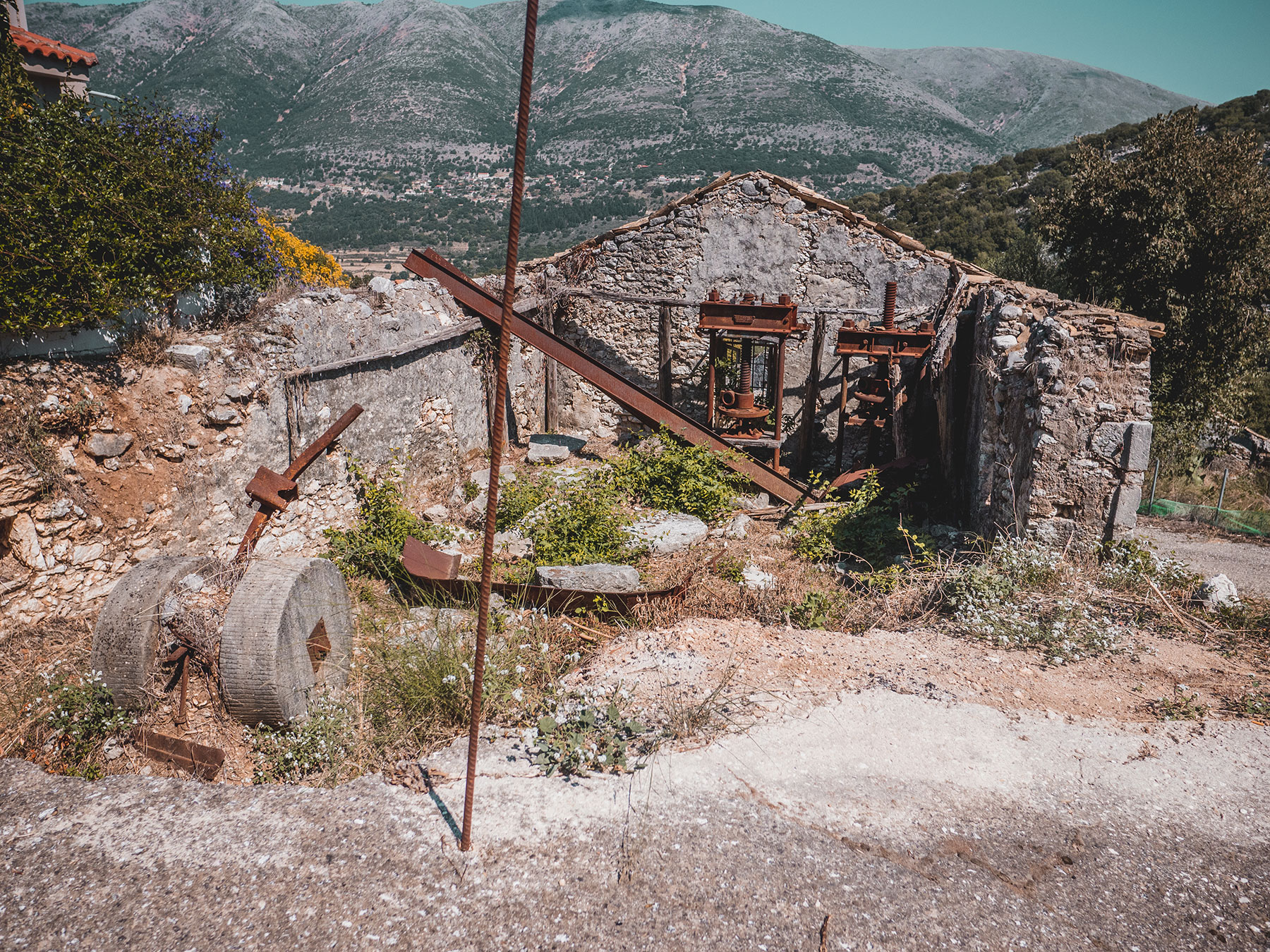

I left the safety of the air-conditioned car and allowed a gentle breeze to roll over me, carrying the scent of wildflowers and tree sap. We were in unchartered territory, well off the beaten tourist path. A quick internet search showed me nothing of this village and so I had absolutely no idea what we would find during our day’s excursions.
A flurry of barking started up from behind me. Startled, I pivoted around to lay eyes on a small yappy dog concealed behind the gated boundary of one of the few renovated houses. I would be glad to leave that fuzzball behind and begin our explorations.
We wandered up a cobbled path which took us higher into the mountains. The first house we came to was in complete disarray. It was roofless and home to a range of trees and bushes. It was, however, the first house that we had encountered where we were not met with a huge drop on the other side of the doorway. So Lewis and I stepped inside.
Today I was smart. I wore Converse to protect my feet and was therefore able to be far more adventurous. There would have been no chance of entering this house without concealed footwear as we were stepping over planks of rotting wood with rusty nails sticking out, jutting boulders and trailing brambles. There was also the constant fear of running into a wasp. Occasionally, buzzing would start-up perilously close to my face and I would be forced to turn and run out of the building in the panicked frenzy that they ignite within me. The little buggers were everywhere.
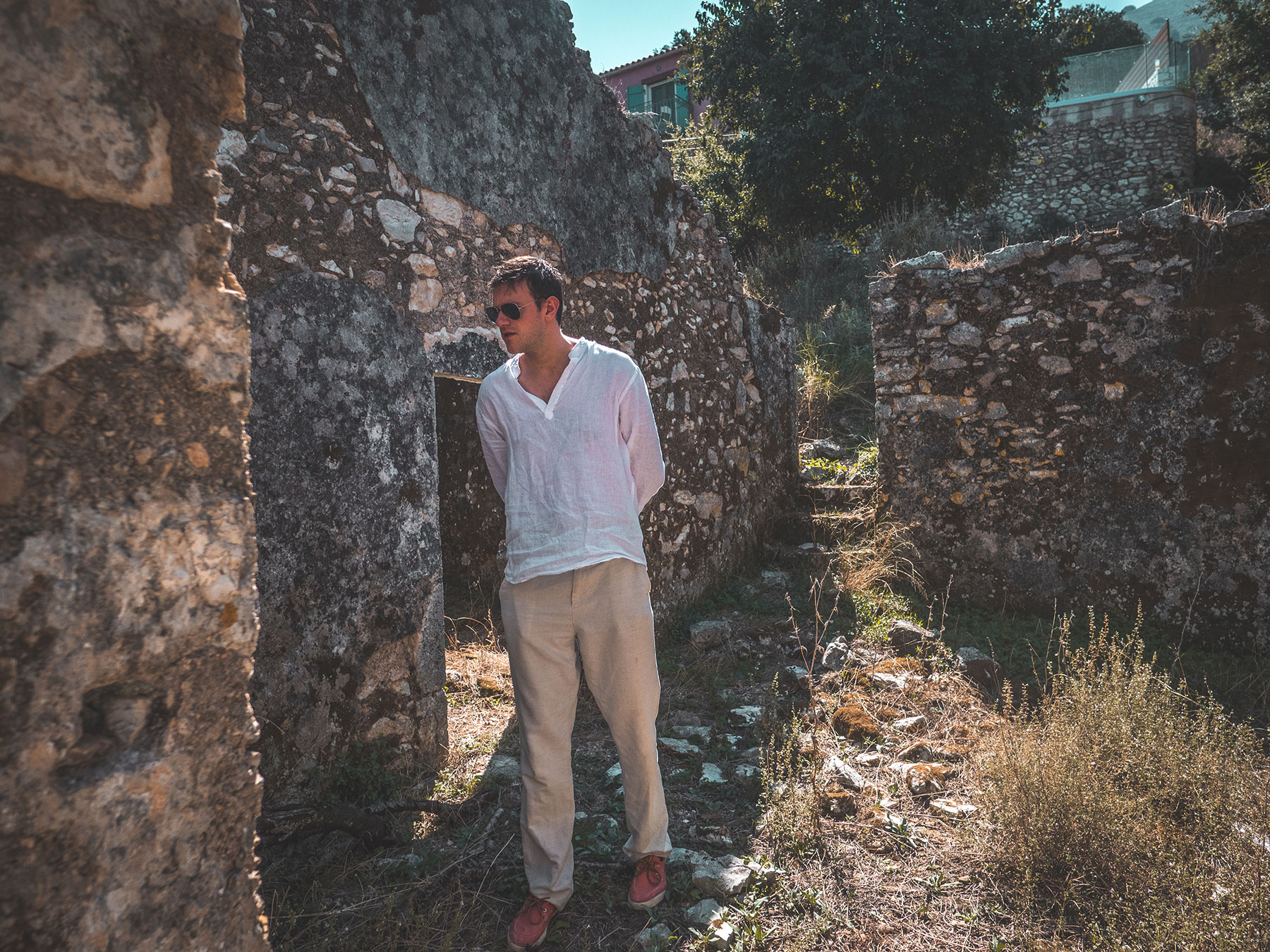
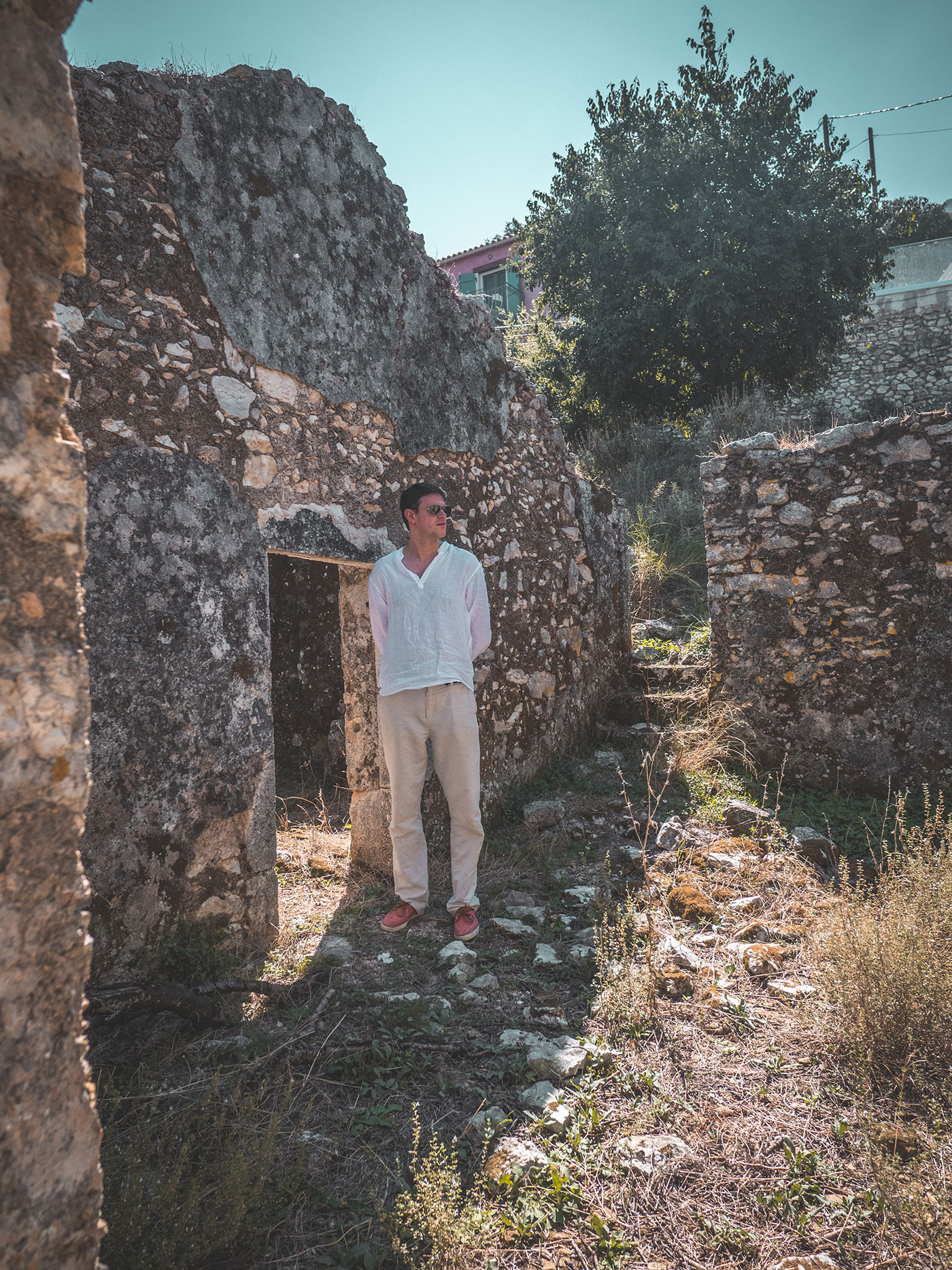
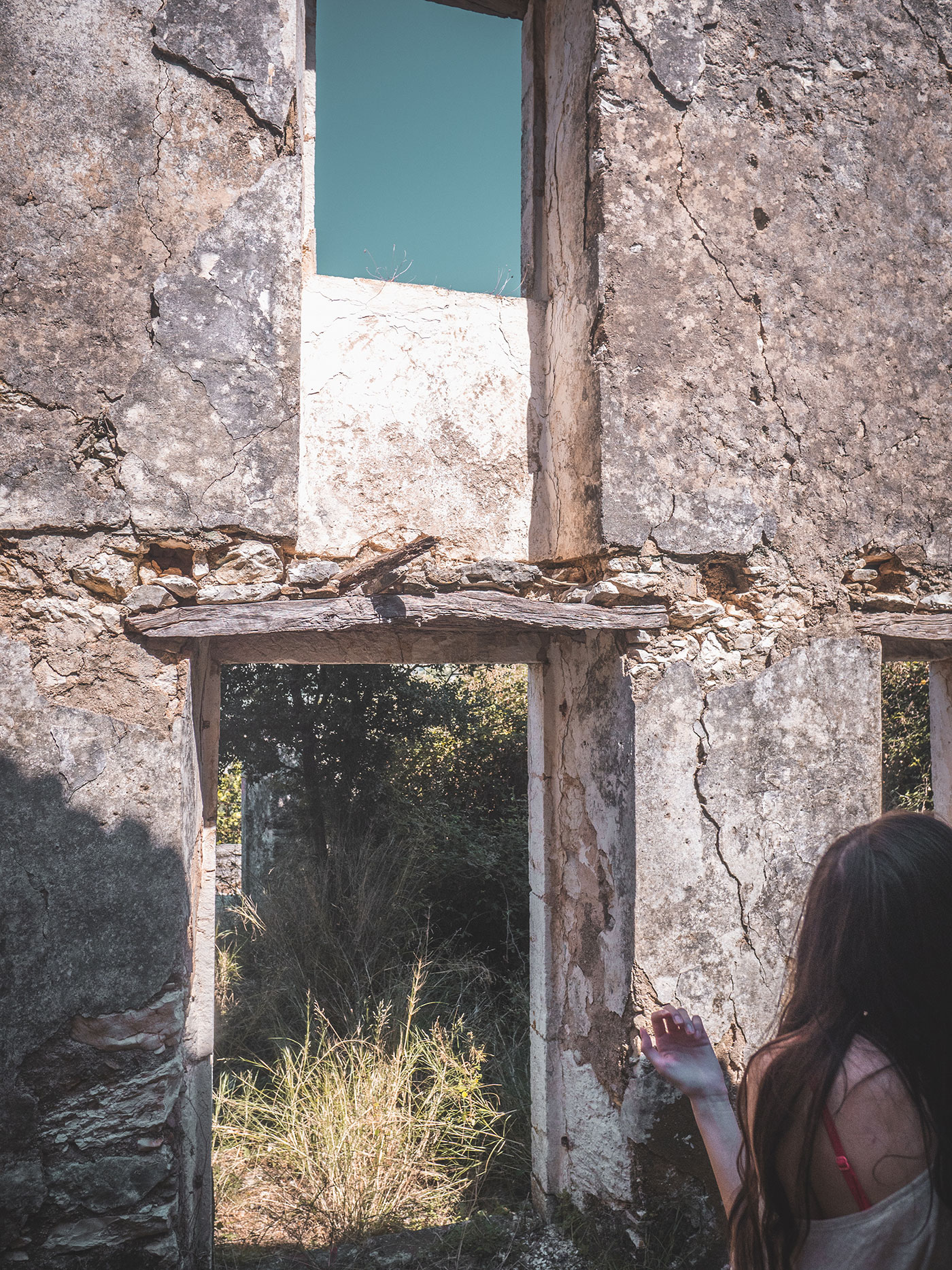



After poking our heads in several rooms, it was time to leave this property. That’s when we noticed a house that almost looked undamaged. The two-storey property was whole and free from destruction, a sturdy roof still sitting firmly atop it. A decaying wooden door was one of the few aspects that showed signs of damage. It was wedged shut with a broom.
A flight of stone steps lead up to the second floor where there were a pair of wooden doors that were partially open. My curiosity was stirred. However, common sense prevailed and we decided it would be best not to climb up anything for fear that the ground would crumble beneath our feet. Instead we decided to circle the house and look for another entrance.






The land around the house sloped up towards the back and I was able to walk right up to a window at the side of the house. Smashed glass lay here with some jagged shards still wedged in place. Behind the glass was a set of dusty curtains. The sight startled me. So far we had witnessed only empty cases of houses which contained little more than stone. But to actually see remnants of life that was once here stirred my soul and made me feel a wave of despair.
I was staring at a pair of curtains. This was once someone’s home. But a terrible, natural tragedy struck which forced its residents to flee. I assume they must have fled as the house was in relatively good condition. However, I could not forget that 600 people sadly lost their lives in the earthquake.



We continued exploring the perimeter of the house. At the back was a narrow passageway that stood between the back wall of the house and a boundary wall behind. It was difficult to navigate our way down here, skirting round overhanging branches of great trees, their arms thick with thorns.
It was down here that we discovered the back entrance to the house. The door was swung off its hinges, allowing us to take a curious peak at what was inside.
I swallowed hard, feeling my heart beating against my ribcage as I took careful steps towards the entrance. Before me was a gaping hole of darkness and I could already feel the stuffy air attacking my lungs, thick with dust.
I placed a hand on the rotting door-frame and carefully balanced my feet at the edge of the house. My eyes were immediately drawn to the floor. A perilous drop stood before me where the floorboards had rotted away. The black hole in the flood was uninviting, the darkness swallowing up whatever was below us. Beyond the hole were brown, dusty floorboards, illuminated by a slit of light which streamed through the open shutters at the front of the house.
I was staring into a large room that stretched from the front to the back of the house. On either side of the room were walkways that led to other rooms. It appeared there were three rooms on this top floor of the house.
The cavernous hole in the floorboards told me that it was foolish to attempt stepping into the house. Clearly, the remaining floorboards were on the verge of collapse. Therefore this window into the rear of the house would be all we’d manage to witness of this once grand building.


Our expedition took us to many more buildings in various states of disrepair. Drakopoulata was not at all like I had expected. I had expected it to contain far more specimens of restored houses, boasting exquisite Greek architecture. However, most buildings here were mere carcasses, albeit interesting to explore and learn about.
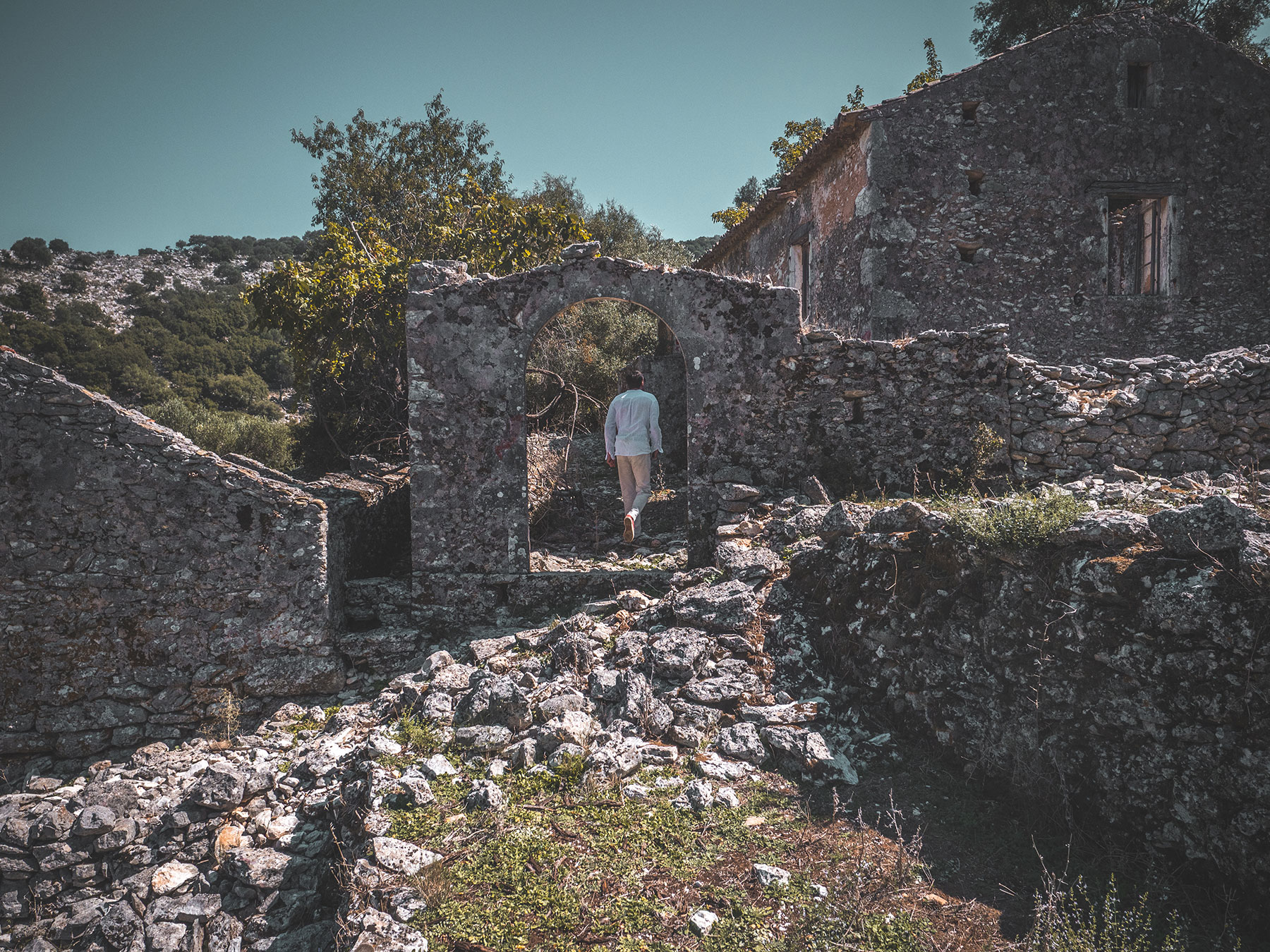


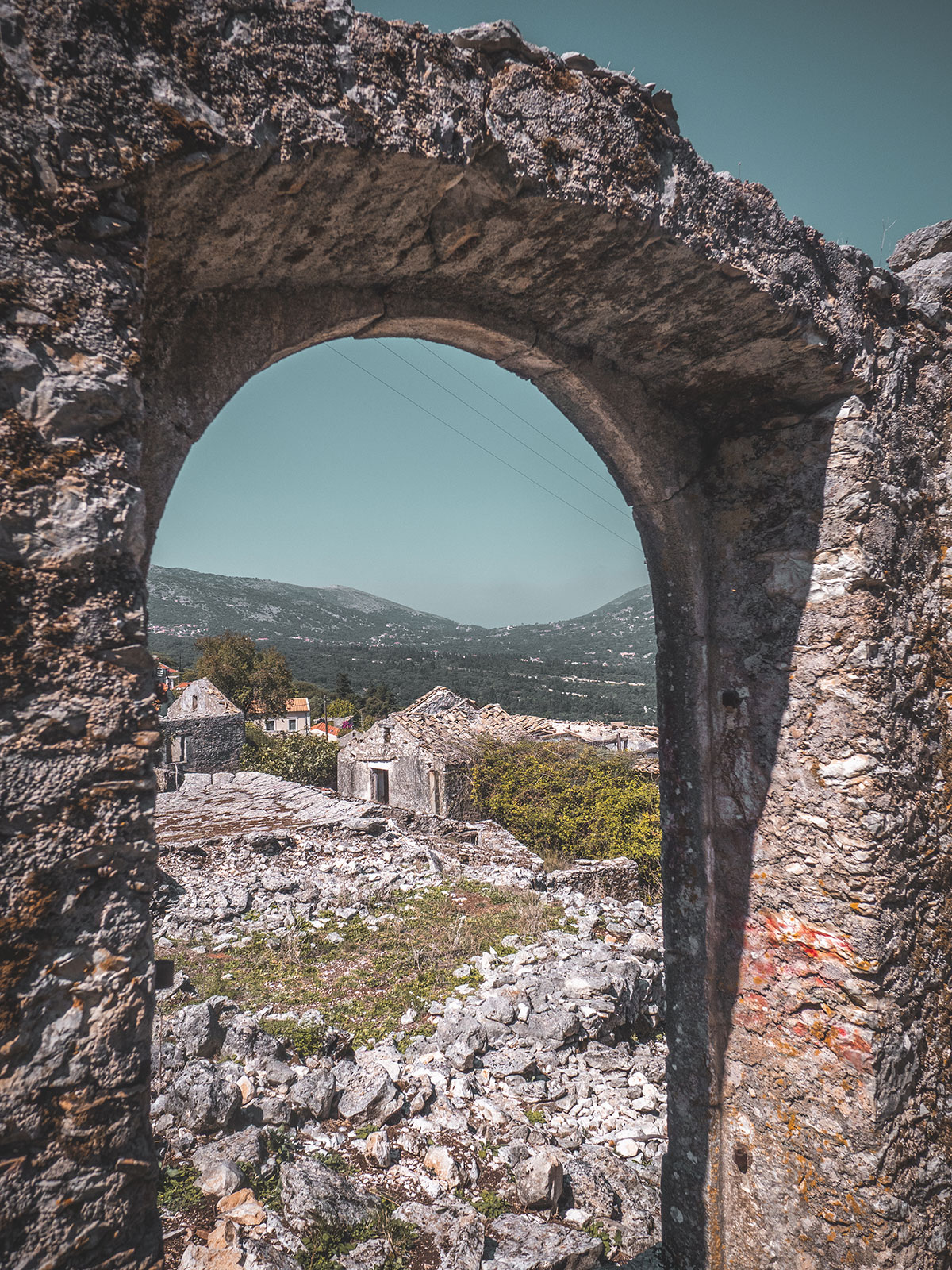


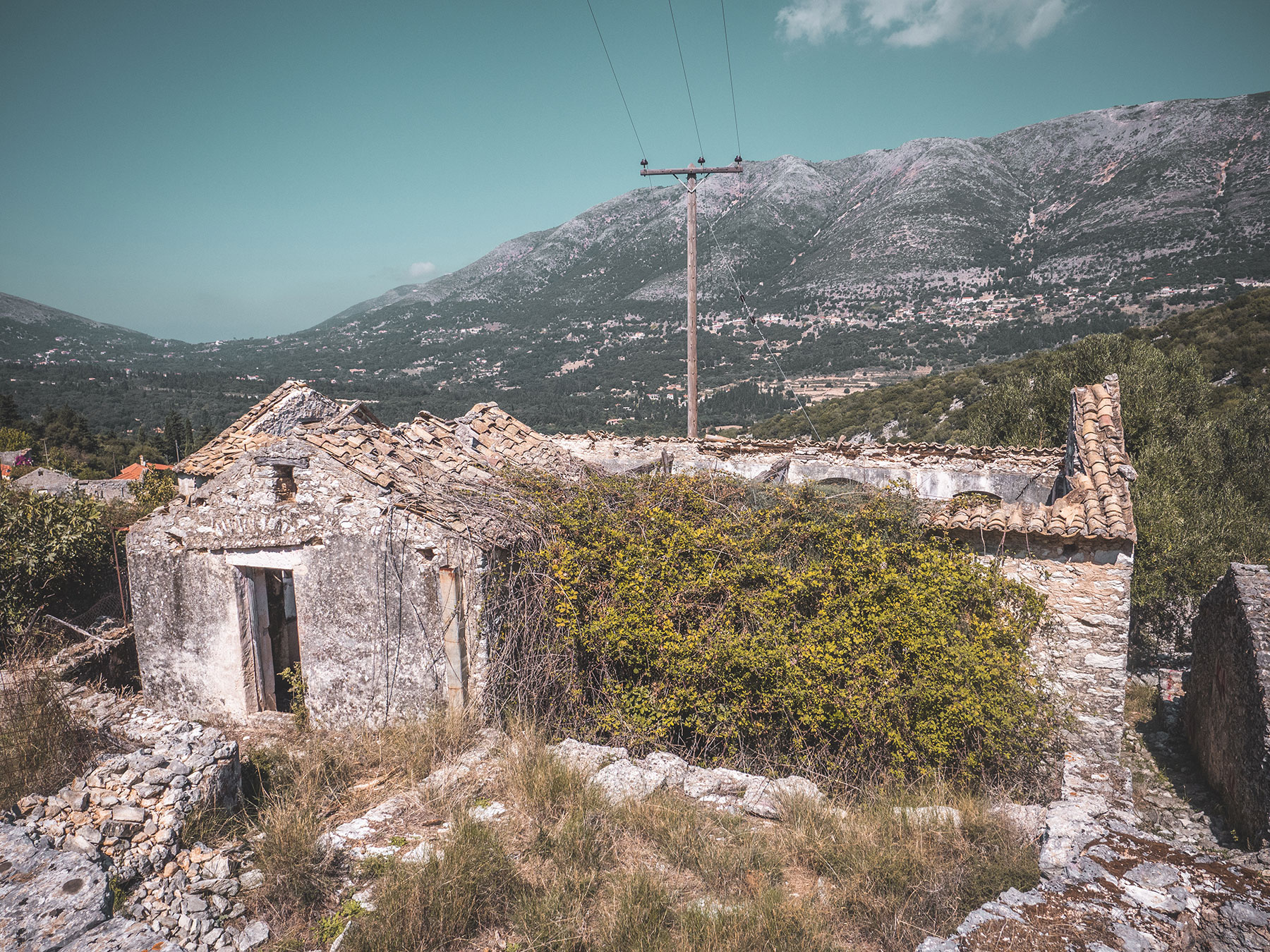

The next building which we stumbled upon halted me in my tracks. I had never seen anything like it.
Approaching from the top, we walked carefully towards the rear entrance. From our explorations to date, it seems common for the traditional houses of Kefalonia to be designed with a rear entrance straight into the top storey of the house. In contrast, front entrances take you to the ground floor.
The wooden door was swung open. Shards of tainted, broken glass hung precariously within the window on the top third of the door.
I skirted the chicken-wire fence hugging the back of the plot and made my way carefully to the open door. Peering inside I took in the state of the destruction before me.
The roof was violently caving in, splinters of heavy beams stabbing down into the floorboards. A thick sheet of a jumble of rubble and shards of wood carpeted the floor in front of me. Sections of the floorboards were no more and in their place were yawning holes of nothingness, a perilous drop to the ground floor below.
The beautiful cyan sky was the backdrop to this chaos and through the broken windows on the other side of the house, I was able to see lush, green mountains. Such contrast.



From our position at the back of the house we were able to clamber down a pile of white stones to the left of the building. Each uneven step down this slope took us clattering down towards the front of the house, which was sited upon a cobbled path.
The front door stood awkwardly on rusty hinges. We were able to nudge it open and risk a glance inside.
I didn’t think it was possible to witness as much destruction as that we had just seen in the first storey of the house. However, the world is full of grim surprises. The floor was heavy with wreckage. Stone, wood and plaster lay together in an unsightly heap. The room was then in two distinct sections, determined by where the roof had caved in. The left of the room was open with sunlight streaming onto the debris below. The right was dark, concealed by a bulging roof that leaked dust and wood. The swelling atop the floorboards suggested that the roof could cave in at any moment.
The skeletal remains of the building were shocking enough to absorb. However, when I turned my eyes to the rubble at my feet, I felt a twinge of sadness to see a shoe buried amongst the wreckage. It was black, torn and sodden with damp. A little way off was a solitary flip-flop, partly concealed by thick dust. It was a choking reminder of the people who once lived here.
High on adrenaline, we chanced a quick look inside. I took one step in, aware of the crushing weight atop the surrendering floorboards above my head. Looking to the right, just beside the door, I laid eyes on yet more belongings. Here there was an ancient bottle of wine, coated in rust and cobwebs. Beside it was an empty metal mug, lying on its side, shrouded in rust.








Retreating to the exit and allowing sunlight to coat my body once more, I felt a heavy weight inside me. It was almost difficult to comprehend the fact that we were standing within the doorway of someone’s home – a home they were forced to flee and never returned to. How must they have felt in that moment? Where were they now? Did the roof collapse in the earthquake or after? Had the residents of this house evacuated beforehand? There were so many unanswered questions.
Moving along, we noticed an open doorway to another room in the same building. Peering inside, we saw that the roof that was giving way was perhaps even more dangerous than the last. Wooden beams curved downwards under their lack of support, held in place by little more than a miracle. As well as the beams hanging down, there were numerous vines, their tendrils wrapping around the top of the building before lowering themselves into the dark, musty room.
In the centre of the floor were the remains of large oak barrels, perhaps to store wine or olives and to the left was the remains of a table, the carcass of one barrel still resting atop it. A small shaft of sunlight lit up the rusty remains of the barrel. Otherwise, the corner was dark and forlorn.




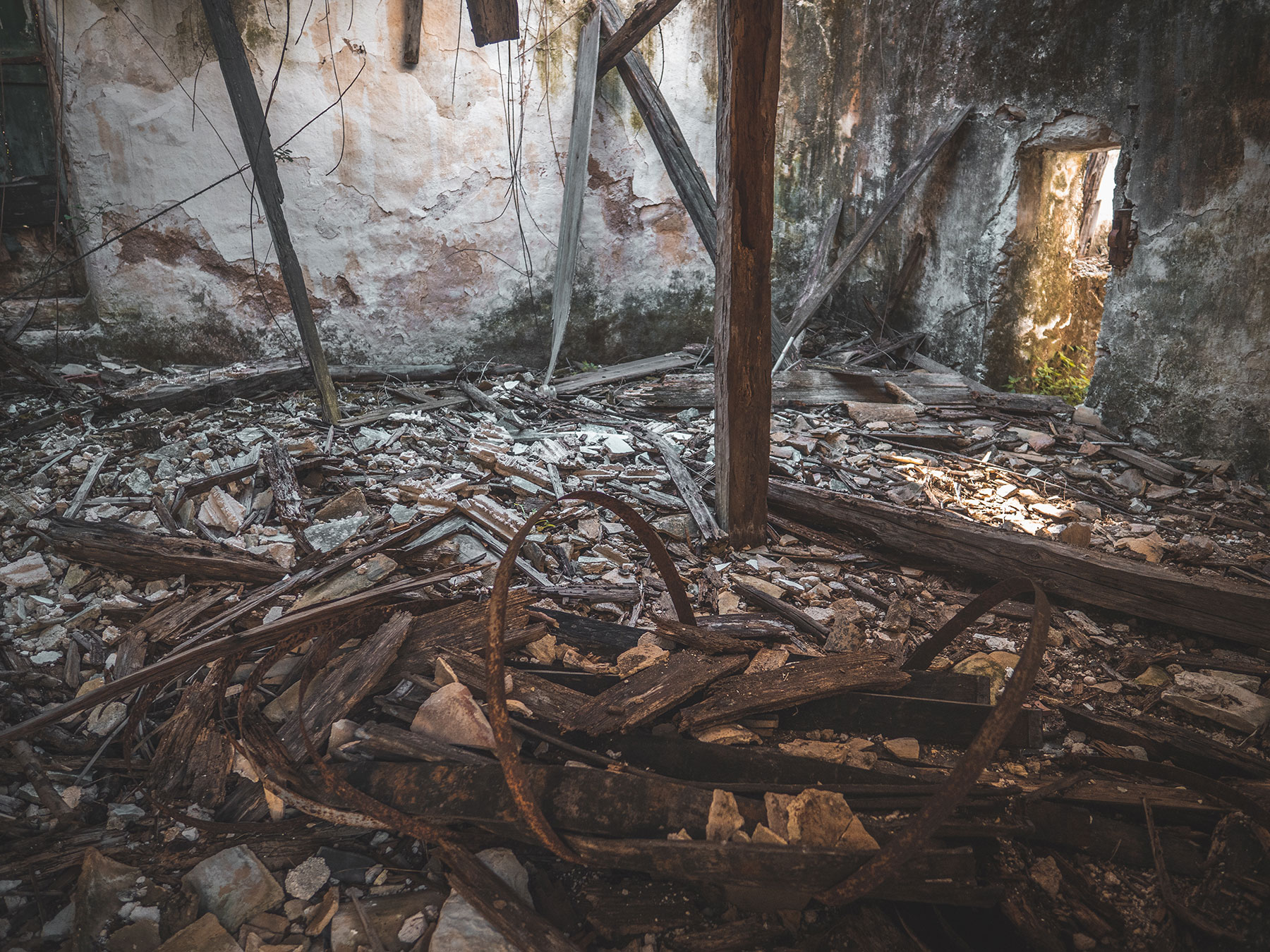

At this point, my lack of water was starting to affect me and so we decided to draw our explorations to a halt and head back to our car. To get there we had to pass a few more settlements. Dotted every so often throughout the Ghost Town was a fully-functional, renovated house. I even saw a huge villa with a swimming pool! It felt so strange.
Amongst the last few houses that we saw was a house with an oven built into one of the inside walls, as well as an out-building with an old-fashioned toilet in. It was essentially a stone hole in the ground.
Comparing the old houses to the new, it was plain to see that character was lacking with the new-builds. They just don’t make things how they used to. Their only plus-points are the fact that the new houses are built to be incredibly earthquake-resistant, to try and prevent any tragedies when future earthquakes strike.
Earthquake resistance is imperative in Kefalonia due to the geography of the island. Kefalonia lies just to the east of a major tectonic fault, where the European tectonic plate meets the Aegean tectonic plate at a slip boundary. Thus there is a high amount of seismic activity in this area.


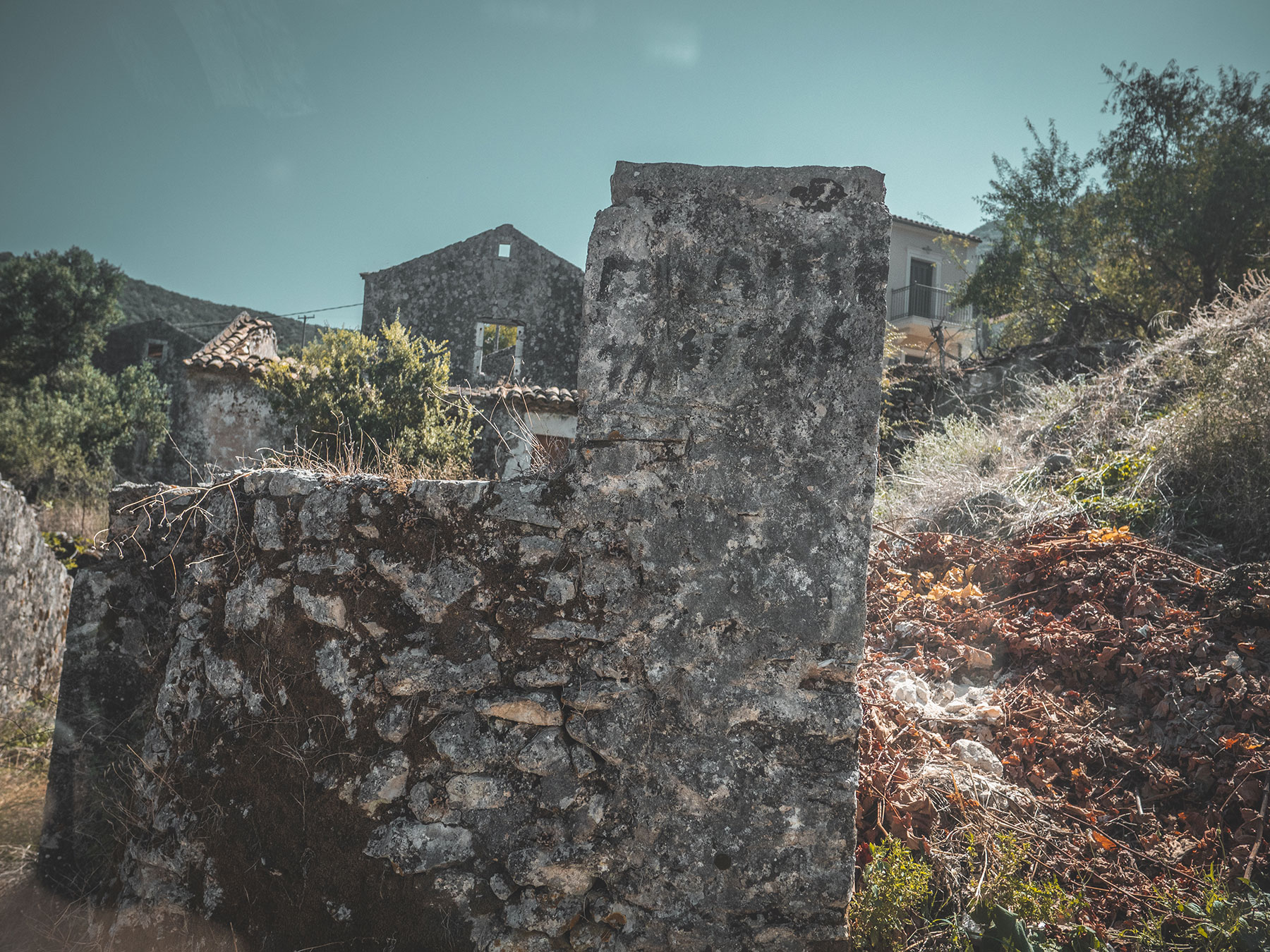
Ellamckendrick.com is a free online resource. If you have found this website useful for planning your adventures, you can show your support by buying me a coffee. Thanks so much!

